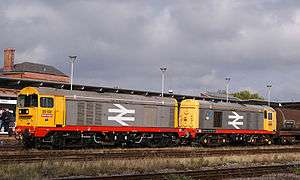British Rail Class 20
|
Nos. 20132 & 20118 working nose-to-nose. | |||||||||||||||||||||||||||||
| |||||||||||||||||||||||||||||
| |||||||||||||||||||||||||||||
The British Rail (BR) Class 20, otherwise known as an English Electric Type 1, is a class of diesel-electric locomotive. In total, 228 locomotives in the class were built by English Electric between 1957 and 1968, the large number being in part because of the failure of other early designs in the same power range to provide reliable locomotives.
The locomotives were originally numbered D8000–D8199 and D8300–D8327. They are known by railway enthusiasts as "Choppers",[3][4] a name derived from the distinctive beat that the engine produced when under load which resembles the sound of a helicopter.
Overview
Designed around relatively basic technology, the 73-tonne locomotives produce 1,000 horsepower (750 kW) and can operate at up to 75 mph (121 km/h). Designed to work light mixed freight traffic, they have no train heating facilities. Locomotives up to D8127 were fitted with disc indicators in the style of the steam era;[5] when headcodes were introduced in 1960 the locomotive’s design was changed to incorporate headcode boxes. Although older locomotives were not retro-fitted with headcode boxes, a few of the earlier batch acquired headcode boxes as a result of repairs. Unusually for British designs, the locomotive had a single cab. This caused serious problems with visibility when travelling nose first, though in these circumstances the driver's view is comparable to that on the steam locomotives that the Class 20s replaced. It was common however to find Class 20s paired together at the nose, with their cabs at opposite ends, ensuring that the driver could quite clearly see the road ahead.

The Class 20 saw only limited service on passenger trains. A small number were fitted with a through pipe for steam heating, primarily for use in conjunction with a Class 37 locomotive on the West Highland Line. Otherwise their use was limited to summer relief services, particularly to Skegness often under the adopted title of The Jolly Fisherman starting from various places including Burton-on-Trent, Stoke-on-Trent, Derby and Leicester. Also occasionally other holiday resorts on the east coast of England, occasional duties as a pilot, and short distance diversions of electric-hauled trains over non-electrified lines.[6]
The shift of light mixed freight to the road network left British Rail with an oversupply of small locomotives. The Class 20s, however, could work in multiple and so handle heavier traffic. Most spent the majority of their working lives coupled nose to nose in pairs to provide a more useful 2,000 hp (1,500 kW) unit and to solve the visibility problems.
Most have now been withdrawn but a few remain with DRS and other minor and industrial operators. Several that are usually operated singly have been fitted with nose-mounted video cameras in order to solve the visibility problems.
The Série 1400 locomotives of Portuguese Railways (CP) are based on the BR Class 20s.
Operation
British Rail
The first batch of Class 20s were allocated to Devons Road depot in Bow, London to work cross-London transfer freights, with the following eight locos allocated to Hornsey depot. After a trial with D8006, D8028–D8034 were allocated for work in highland Scotland, and had tablet catcher recesses built into the cabsides. D8035–D8044 were originally to be allocated to Norwich, but were actually used for empty coaching stock (ECS) workings in and out of London Euston. D8050–D8069 were allocated to the new Tinsley TMD in Sheffield, from where they regularly worked into Lincolnshire and Humberside. D8070–D8127 were sent to operate in the Scottish lowlands, particularly in the Forth-Clyde area, and the Fife coalfield. This completed the original orders for 128 locos, the last being delivered in August 1962.
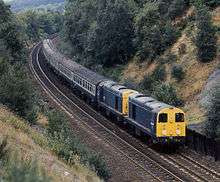
With the subsequent order for a further 100 Class 20 locos, deliveries recommenced with D8128 in January 1966. Tests in 1967 using D8179 and D8317 resulted in locos from D8316 being delivered from the manufacturer with the new electronic control system for working merry-go-round (MGR) coal trains. Trains to Longannet Power Station sometimes required locos to triple-head trains.[3]
After privatisation
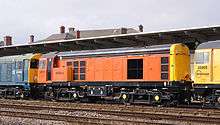
Some Class 20s were used on the construction of the Channel Tunnel and High Speed 1 and some even made their way to France to work for the Compagnie des chemins de Fer Départementaux (CFD) in industry there, although these have since been repatriated. Some locos have in the past been hired by Hunslet-Barclay to provide motive power for weedkilling trains.
Direct Rail Services' (DRS) fleet of Class 20/3s has at times seen frequent work across Britain in pairs, or with Class 37s, on nuclear flask trains, the company's speciality. DRS supply class 20s for use with the Rail Head Treatment Train during the winter. Perhaps the most unusual train hauled by a Class 20 was the Kosovo Train for Life charter train in Autumn 1999 which carried 800 tonnes of aid. Leaving London's Kensington Olympia station on 17 September 1999,[7] the train was hauled by 20901, 20902 and 20903 throughout, reaching Prague by 20 September[8] and arrived at Pristina station at 10:00 on 25 September 1999.[9]
DRS initially had a fleet of 15 operational Class 20/3 locomotives. Three of these have subsequently been disposed of for scrap, after stripping for spares, whilst a further two have been sold on to HNRC.
In 2005, Harry Needle Railroad Company (HNRC) acquired a large number of 20/0s and 20/9s from the DRS stored fleet. By May 2008 HNRC had 16 Class 20s in storage and 8 operational of which two were on hire at Corus Scunthorpe (nos 81 and 82).
A number of class 20s from HNRC are currently being employed to deliver new S-Stock to London Underground. at Neasden depot, for commissioning.
Sub-classes
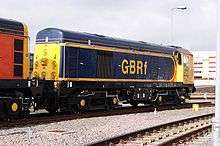
| Sub-Class | Description |
|---|---|
| 20/0 | Standard as-built locos. |
| 20/3 (BR) | A small fleet of standard Class 20/0's modified for Peak Forest aggregate workings. |
| 20/3 (DRS) | DRS-owned/operated locos fitted with modified cab equipment and fully refurbished, use of electronics and various other modifications. A pair of these locomotives, 20311 & 20314, have subsequently been sold to HNRC. |
| 20/9 | Modified from Class 20/0 after withdrawal and sold to Hunslet-Barclay for contract freight use and remote-control trialing. Few technical differences from standard locos. Subsequently sold to DRS, and latterly to HNRC (of which 20901, 903-906 remain - 20902 has been scrapped). |
Liveries
British Rail
D8000 was delivered in June 1957 in overall green livery, with grey footplate,[5] red bufferbeams and a grey roof extending down the bodyside to the edge of the roof panels.[10] The original batch of 10 locos bore the BR crest facing towards the nose on both sides, used yellow sans serif numerals, and had green cab roofs; locos from D8010 had the correct pattern BR crest, white numerals and grey cab roof.[5] This was adjusted after D8103[5] to include a small yellow warning panel, although the precise size and detail of such panels varied somewhat.[3]
In 1966, D8048 was selected by the BR design panel for livery experiments and was painted in the prototype standard blue, including the bufferbeams and roof. The exceptions were the full yellow front ends and a black underframe.[11] After the adoption of Rail Blue as the BR livery, D8178 became one of the first locomotives to be delivered in this livery (along with Class 25 D7660 and Class 47 D1953)[11] and all subsequent locomotives were delivered in this livery. Despite this, some locos continued to be returned to traffic in green livery, although often with the later BR "double arrow" logo and data panel;[5] thus 20141 was the final main line loco to carry BR green livery.[12]
Some locomotives, including 20227, were repainted in the Railfreight grey livery with red sole bars, yellow ends and large double arrows on the sides.
At least four of the class were painted in the British Rail Telecommunications livery:[13]
- 20075 - Sir William Cooke - rebuilt as 20309 and in service with DRS
- 20128 - Guglielmo Marconi - rebuilt as 20307 and has been scrapped
- 20131 - Almon B. Strowger - rebuilt as 20306 and has been scrapped
- 20187 - Sir Charles Wheatstone - rebuilt as 20308 and in service with DRS
Privatisation
Class 20/3 locomotives operated by DRS have all been painted in DRS Oxford Blue livery, with red bufferbeams and full yellow ends. There have been small variations in the shade of yellow used on these locos, and the penetration of blue from the sides onto the ends.
Class 20 locomotives operated by the Harry Needle Railroad Company (HNRC) are painted into house colours of orange and black, with yellow nose ends (20121, 20166, 20311 and 20314). Some other locomotives owned by HNRC, of subclasses 20/0 and 20/9, have been painted in a variation of two-tone Railfreight grey livery. These have dark grey roof, mid-grey upper body and light grey lower body, black underframe and buffer beam. The nose ends are painted yellow, with the lower part of the cab end in yellow and the upper part black, this continuing around the cab sides but with the light grey instead of yellow. Others are in BR Blue or Railfreight Red-stripe livery. HNRC Class 20's on long-term hire to Corus were painted in Corus livery; previously silver but currently a bright yellow with red solebar (No.81 - 20056). Since the Corus business was bought by the Indian Tata Steel group, some of these locomotives have been repainted into Tata Blue livery (No.82 - 20066). Two HNRC Class 20's have been painted into GBRf Europorte's blue and gold livery (20901 and 20905), while two other HNRC Class 20's have been painted in the White livery of Hope Construction Materials, with a purple solebar (No.2 - 20168) and a black solebar (No.3 - 20906).
Four locomotives carried the orange and white livery of the CFD (Compagnie de Chemins de Fer Départementaux') whilst working in France, these were 20035, 20063, 20139 and 20228.
Two locomotives, numbers 20142 and 20189, were briefly painted into a Blue and White Balfour Beatty livery, during 2013, but have been returned to a variation of BR blue since.
The last built class 20, number 20227, has been used extensively on the London Underground network. In the mid-2000s it was painted in Metropolitan maroon livery and named "Sir John Betjeman" by the Class 20 Locomotive Society as acknowledgement of this work. It is now in a special 'modern taste' LUL-based livery, to mark the London Underground 150 celebrations.
Mainline registered class 20s are:[14]
| Sub-Class | Description |
|---|---|
| 20/0 | 20096, 20107, 20118, 20132, 20142, 20168, 20189, 20205, 20227 |
| 20/3 | 20301, 20302, 20303, 20304, 20305, 20308, 20309, 20311, 20312, 20314 |
| 20/9 | 20901, 20905, 20906 |
In popular culture
In the 1995 James Bond film GoldenEye, 20188 was used as the locomotive of an escape train on the Nene Valley Railway, with the addition of armour plating to give the impression of a Russian armoured locomotive.[15]
Preservation
A total of 22 Class 20 locomotives are preserved, including the first of the class built, D8000, which is part of the National Railway Collection at the National Railway Museum in York.
| TOPS number | Current number | Photo | Preserved by | Location | Notes |
|---|---|---|---|---|---|
| 20001 | D8001 | | Class 20 Locomotive Society | Midland Railway – Butterley | |
| 20007 | D8007 | | English Electric Preservation | Great Central Railway (Nottingham) | |
| 20020 | 20020 | | Scottish Railway Preservation Society | Bo'ness and Kinneil Railway | |
| 20031 | 20031 | 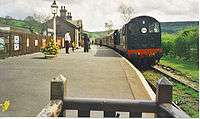 | Privately owned | Keighley & Worth Valley Railway | |
| 20035 | 20035 | Privately owned, ex-CFD | Gloucestershire Warwickshire Railway | ||
| 20048 | 20048 | 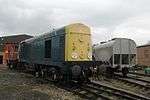 | Midland Class 20 Association | Midland Railway, Butterley | |
| 20050 | D8000 |  | National Collection | National Railway Museum | |
| 20059 | D8059 | .jpg) | Somerset & Dorset Loco Company | Severn Valley Railway | |
| 20069 | D8069 | 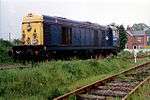 | Privately owned | Mid-Norfolk Railway | |
| 20098 | D8098 |  | Type One Locomotive Company | Great Central Railway, Loughborough | |
| 20137 | D8137 | .jpg) | Privately owned | Gloucestershire Warwickshire Railway | |
| 20142 | 20142 | .jpg) | Class 20189 Ltd | Mainline operational | |
| 20154 | 20154 | | English Electric Preservation | Great Central Railway (Nottingham) | |
| 20166 | D8166 |  | Privately owned | Wensleydale Railway | |
| 20177 | 20177 | | Somerset & Dorset Loco Company | Severn Valley Railway | Stored, being used as a source of spare parts for other S&D Class 20 locomotives |
| 20188 | D8188 | _(8061968481).jpg) | Somerset & Dorset Loco Company | Severn Valley Railway | |
| 20189 | L189 | .jpg) | Class 20189 Ltd | Mainline operational | |
| 20205 | 20205 | 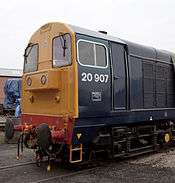 | Class 20 Locomotive Society | Mainline operational | |
| 20214 | 20214 | Privately owned | Lakeside and Haverthwaite Railway | ||
| 20227 | 20227 | 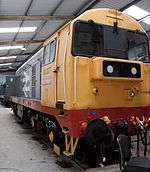 | Class 20 Locomotive Society | Midland Railway - Butterley | |
| 20228 | 2004 | Privately owned | Vale of Glamorgan Railway |
Models
Hornby Dublo, later Wrenn, made an 00-gauge plastic-bodied model class 20 from 1958 until the 1970s. In 2008, Hornby produced several of the Class 20 in various liveries in 00 gauge, which were all based on the old Lima tooling. Bachmann Branchline (00) has its own version of the model in various liveries. Also with DCC sound-fitted locomotives. Bachmann (Graham Farish) has also produced a model in various liveries in N gauge. A new Resin bodied kit is produced by 3mm Scale Model Railways (TT gauge)
Notes
- ↑ 20084 fitted with additional tanks giving a total capacity of 1,040 gallons.[1]</ref>Lubricant cap
100 imp gal (450 l; 120 US gal)[1]Coolant cap
130 imp gal (590 l; 160 US gal)[1]Prime mover
English Electric 8 SVT Mk.II[1]Generator
DCTraction motors
D8000–D8049: EE 526/5D
Remainder: EE 526/8D[1]Cylinder size 10 in (250 mm)[1]Transmission Diesel electricGear ratio 63:17[1]MU working ★ Blue StarTrain heating NoneTrain brakes Vacuum, Dual or AirPerformance figures Maximum speed 75 mph (121 km/h) Power output Engine: 1,000 hp (746 kW) Tractive effort Maximum: 42,000 lbf (186.8 kN)
Continuous: 25,000 lbf (111.2 kN)@ 11 mph (17.7 km/h)[2]Loco brakeforce 35 long tons-force (349 kN) Career Operators Direct Rail Services
HNRCNumbers D8000–D8199, D8300–D8327; later 20001–20228 Nicknames Chopper<ref name='RE6'>Bellass, Eddie; Slater, Jim (December 1981 – January 1982). "BR's 'Chopper' squad". Rail Enthusiast. EMAP National Publications. pp. 6–9. ISSN 0262-561X. OCLC 49957965.
References
- 1 2 3 4 5 6 7 8 9 10 11 12 13 14 15 16 Marsden & Fenn 1988, p. 71
- ↑ Shipman, Mark (3 July 2004). "Class 20". Locomotive Photo Gallery. Archived from the original on 24 October 2004. Retrieved 30 December 2013.
- 1 2 3 Oakley, Michael (1981). BR Class 20 diesels. Truro: Bradford Barton / D&EG. ISBN 0-85153-419-8.
- ↑ "'At least 20 20s' for Barrow Hill diesel jubilee". The Railway Magazine. July 2007. p. 9.
- 1 2 3 4 5 Wells, Monty (November 1982). "Tweak a Twenty". Railway Modeller. Vol. 33 no. 385. Seaton, Devon: Peco Publications & Publicity Ltd. pp. 398–401.
- ↑ Webster, Neal; Greaves, Simon; Greengrass, Robert (1985). Loco-Hauled Travel 1985-6. Bradford: Metro Enterprises. ISBN 0-947773-02-9.
- ↑ "Pickersgill-Kaye sponsor Kosovo train for life". Pickersgill-Kaye Ltd. 27 September 1999. Retrieved 20 May 2008.
- ↑ "Class 20". The Railway Centre.com. Archived from the original on 27 September 2013. Retrieved 20 May 2008.
- ↑ "Train of life in Kosovo". BBC News. BBC. 25 September 1999. Retrieved 20 May 2008.
- ↑ Stevens-Stratten, S.W.; Carter, R.S. (1978). British Rail Main-Line Diesels. Shepperton: Ian Allan Ltd. ISBN 0-7110-0617-2.
- 1 2 Turner, Graham (2012). "Rail Blue - The Story". Rail Blue. Retrieved 20 March 2008.
- ↑ Turner, Graham. "The Class 20 Locomotive Fleet". Retrieved 25 November 2008.
- ↑ BR Telecommunications Ltd; Hallas, Sam; Ward, Chris. "BR Telecommunications Locomotives" (Article). samhallas.co.uk. Archived from the original on 16 September 2013. Retrieved 30 December 2013.
- ↑ Snook, William. The UK Railway Datafile 2015. p. .
- ↑ "Sinister Class 20 is new James Bond movie star" Rail issue 250 12 April 1995 page 6
- ↑ "Preserved Diesels - Class 20". Preserved Diesels. Retrieved 15 August 2008.
Sources
- Marsden, Colin J. (1981). Motive power recognition:1 Locomotives. Shepperton: Ian Allan Ltd. ISBN 0-7110-1109-5.
- Marsden, Colin J.; Fenn, Graham B. (1988). British Rail Main Line Diesel Locomotives. Oxford Publishing Co. ISBN 9780860933182. OCLC 17916362.
Further reading
- Cole, Andrew (2016). Class 20 Locomotives. Amberley Publishing. ISBN 9781445658919. OCLC 934603402.
- Dunn, Pip (2016). British Rail Class 20 Locomotives. The Crowood Press UK. ISBN 9781785000980. OCLC 930829335.
- Dunn, Pip; Loader, Martin (2003). Class 20 Photo File. Vanguard Publications. ISBN 9781900872058. OCLC 867918624.
- Fell, Andrew (1994). Class 20s in Colour. Leicester: Midland Publishing Ltd. ISBN 9781857800203. OCLC 31287783.
- McManus, Michael. Ultimate Allocations, British Railways Locomotives 1948 - 1968. Wirral. Michael McManus.
- Oakley, Michael (1981). BR Class 20 Diesels. Truro: Bradford Barton. ISBN 9780851534190. OCLC 16542512.
- Vaughan, John (1984). Profile of the class 20s. Poole: OPC. ISBN 9780860932444. OCLC 13666530.
- Johnston, Howard (April 1983). "When Class 20s go on holiday". Rail Enthusiast. EMAP National Publications. pp. 16–21. ISSN 0262-561X. OCLC 49957965.
- "Outlines of Power No. 4: EE Type 1 (Class 20)". Rail Enthusiast. EMAP National Publications. February 1983. pp. 32–33. ISSN 0262-561X. OCLC 49957965.
- "The 'new' Class 20/9 takes to the rails". RAIL. No. 93. EMAP National Publications. 6–19 April 1989. p. 8. ISSN 0953-4563. OCLC 49953699.
- Dunn, Pip (26 February – 11 March 1997). "They'll always get you home!". RAIL. No. 299. EMAP Apex Publications. p. 32-36. ISSN 0953-4563. OCLC 49953699.
- Dunn, Pip (5–18 November 1997). "PDQ". RAIL. No. 317. EMAP Apex Publications. p. 37. ISSN 0953-4563. OCLC 49953699.
- Dunn, Pip (11–24 February 1998). "Second batch of DRS '20s' nearly ready". RAIL. No. 324. EMAP Apex Publications. pp. 60–61. ISSN 0953-4563. OCLC 49953699.
- Dunn, Pip (9–22 September 1998). "Enjoying the atmosphere of France '98!". RAIL. No. 339. EMAP Apex Publications. pp. 36–41. ISSN 0953-4563. OCLC 49953699.
External links
| Wikimedia Commons has media related to British Rail Class 20. |
- Preserved locomotive database
- Class 20 Locomotive Society
- Disposal details for Class 20s at WNXX (subscription required)
- Class 20 locomotive fleet at Railblue.com
- BRT Locos
- Images of Class 20s from various periods of UK operation
